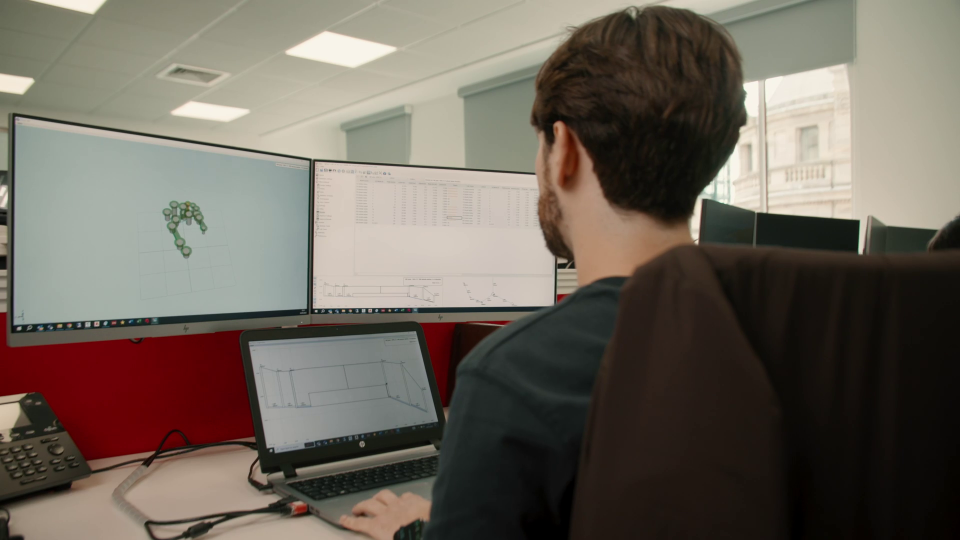Effective drainage design has never been more critical. With flash floods regularly in the news and projections for more intense rainfall in the years to come, civil engineers with drainage expertise are in high demand.
Traditionally, drainage design relied on extensive paper-based calculations, drawings, spreadsheets and generic computer software. However, in recent years specialised drainage design programmes have gained popularity in the industry.
What is drainage design software, and why should you consider using it?
What is drainage design software?
Drainage design software provides civil engineers with a computer-based system to digitally draw a model of a site and their proposed drainage strategy. Once a user has created a design, they can model hydraulic behaviours, test drainage systems (such as storm, foul water, or SuDS), and adapt the model as a site’s wider design evolves.
Some drainage design systems like Causeway Flow also integrate with CAD programmes like Autodesk. This means that drainage design can be mapped onto the wider site design, including BIM plans, for improved visibility that enables optimal design.
5 benefits of drainage design software
The use of drainage design software is essential in civil engineering. Here are five key benefits of using this kind of technology to design drainage systems.
1. Provides visual representation of the site
If you are producing drainage designs for a large project - such as a residential or mixed development or a highway project – you need to keep the ‘bigger picture’ in mind when planning drainage.
Drainage design software provides you with a visual representation of your complete model, allowing you to analyse overland water flow along with fluvial and pluvial flooding to see how the entire site is connected. Moreover, each time you make changes to the model, this will automatically calculate changes to hydraulics throughout the site.
Being able to analyse the site and visualise the entire model means the engineer can better understand the impact of different water management systems - be they SuDS, ponds or traditional drainage - informing your design decisions and quickly identifying any potential problems.
2. Avoid design clashes between infrastructure disciplines
One of the biggest drainage design challenges is when other engineering disciplines’ plans clash with your team’s detailed drainage designs.
For example, an engineer at another company may have decided to change the road layout on a project without considering its impacts on surface water or hydraulics. Unfortunately, these kinds of conflicts can be challenging to convey verbally.
Once again, drainage design software makes it much easier to communicate with other disciplines. By using a visual representation, you can show them how a change elsewhere could potentially lead to water flow management problems on the site.
The latest innovations in design software have brought advancements to fully integrate disciplines in a single design environment. This means when you move a road, all other infrastructure - including the drainage design - is updated live to reflect this change, avoiding costly errors.
Learn more: 7 ways to boost drainage design productivity
3. Ask 'what if?'
Effective drainage design is all about considering alternative scenarios to solve how water can be controlled and stored effectively on a site.
What if, for instance, three months’ worth of rain falls in just one afternoon? Could your stormwater system withstand this rare but plausible deluge? A drainage design programme allows you to test for this kind of extreme event.
Drainage design software also lets you assess the impact of innovative drainage techniques such as sustainable urban drainage systems (SuDS), rain gardens and other innovative solutions. Enabling engineers to deliver more sustainable drainage solutions that protect infrastructure from future climate change scenarios.
This is becoming increasingly essential as authorities request more detail on extreme events.
4. Design more efficiently
Another benefit of drainage design software is that it allows you to design systems faster and more efficiently. The technology can identify design clashes, perform automatic calculations, and let you quickly mock-up a site while adding more detail as you go.
Tools like Causeway Flow let you streamline your design workflows and quickly conduct feasibility studies for pre-planning, before progressing to detailed design. They can also help you verify that your design complies with legislation and building regulations, thereby speeding up the approval process.
5. Adapt design to deliver changes fast
Design changes are inevitable and can be the most time-consuming part of the process. By using the latest technology, any design changes can be made automatically, saving hours that you can refocus on more value-adding tasks.
Case study: How Sir Robert McAlpine uses drainage design software
Learn more about drainage design software
It is increasingly common for civil engineers to use sophisticated software to design drainage systems. Today, many of your clients will expect complex designs to fit their specifications, while approving authorities demand that you meet requirements in a short timeframe.
Causeway Flow is the leading drainage design solution available on the UK market. It provides you with an end-to-end system that supports planning, SuDS design, integrated design workflows and visualisation to support your drainage design efforts and boost productivity. Ultimately ensuring you can deliver designs for quick approval on time and on budget.
Learn more about Flow in this video, or get in touch to request a demo.


%20adoption%20and%20approval%20in%20Wales.webp)
